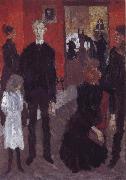Wholesale Oil Painting Reproductions No Minimum and Door to Door! |
|||||||||||
|
|
|||||||||||

|
|||||||||||
|
|
|
||||||||
All Max Beckmann Oil Paintings |
||||||||
|
|
||||||||
|
|
||||||||
|
Artist Introduction: 1884-1950
was a German painter, draftsman, printmaker, sculptor, and writer. Although he is usually classified as an Expressionist artist, he rejected both the term and the movement. In the 1920s he was associated with the New Objectivity (Neue Sachlichkeit), an outgrowth of Expressionism that opposed its introverted emotionalism. He was born into a middle-class family in Leipzig, Saxony. From his youth he pitted himself against the old masters. His traumatic experiences of World War I, in which he served as a medic, coincided with a dramatic transformation of his style from academically correct depictions to a distortion of both figure and space, reflecting his altered vision of himself and humanity.He is known for the self-portraits he painted throughout his life, their number and intensity rivalled only by Rembrandt and Picasso. Well-read in philosophy and literature, he also contemplated mysticism and theosophy in search of the "Self". As a true painter-thinker, he strove to find the hidden spiritual dimension in his subjects. (Beckmann's 1948 "Letters to a Woman Painter" provides a statement of his approach to art.) In the Weimar Republic of the Twenties, Beckmann enjoyed great success and official honors. In 1927 he received the Honorary Empire Prize for German Art and the Gold Medal of the City of D??sseldorf; the National Gallery in Berlin acquired his painting The Bark and, in 1928, purchased his Self-Portrait in Tuxedo.In 1925 he was selected to teach a master class at the Städelschule Academy of Fine Art in Frankfurt. Some of his most famous students included Theo Garve, Leo Maillet and Marie-Louise Von Motesiczky. His fortunes changed with the rise to power of Adolf Hitler, whose dislike of Modern Art quickly led to its suppression by the state. In 1933, the Nazi government bizarrely called Beckmann a "cultural Bolshevik"and dismissed him from his teaching position at the Art School in Frankfurt. In 1937 more than 500 of his works were confiscated from German museums, and several of these works were put on display in the notorious Degenerate Art exhibition in Munich.For ten years, Beckmann lived in poverty in self-imposed exile in Amsterdam, failing in his desperate attempts to obtain a visa for the US. In 1944 the Germans attempted to draft him into the army, despite the fact that the sixty-year-old artist had suffered a heart attack. The works completed in his Amsterdam studio were even more powerful and intense than the ones of his master years in Frankfurt, and included several large triptychs, which stand as a summation of Beckmann's art. After the war, Beckmann moved to the United States, and during the last three years of his life, he taught at the art schools of Washington University in St. Louis (with the German-American painter and printmaker Werner Drewes) and the Brooklyn Museum. He suffered from angina pectoris and died after Christmas 1950, struck down by a heart attack in Manhattan.Many of his late paintings are now displayed in American museums. |
||||||||
|
|
||||||||
|
Small Death Scene Painting ID:: 38679 |
mk138
1906
Oil on canvas
117x71cm
|
|||||||
Height Width |
INS/CM Quality |
|||||||
|
CONTACT US |

